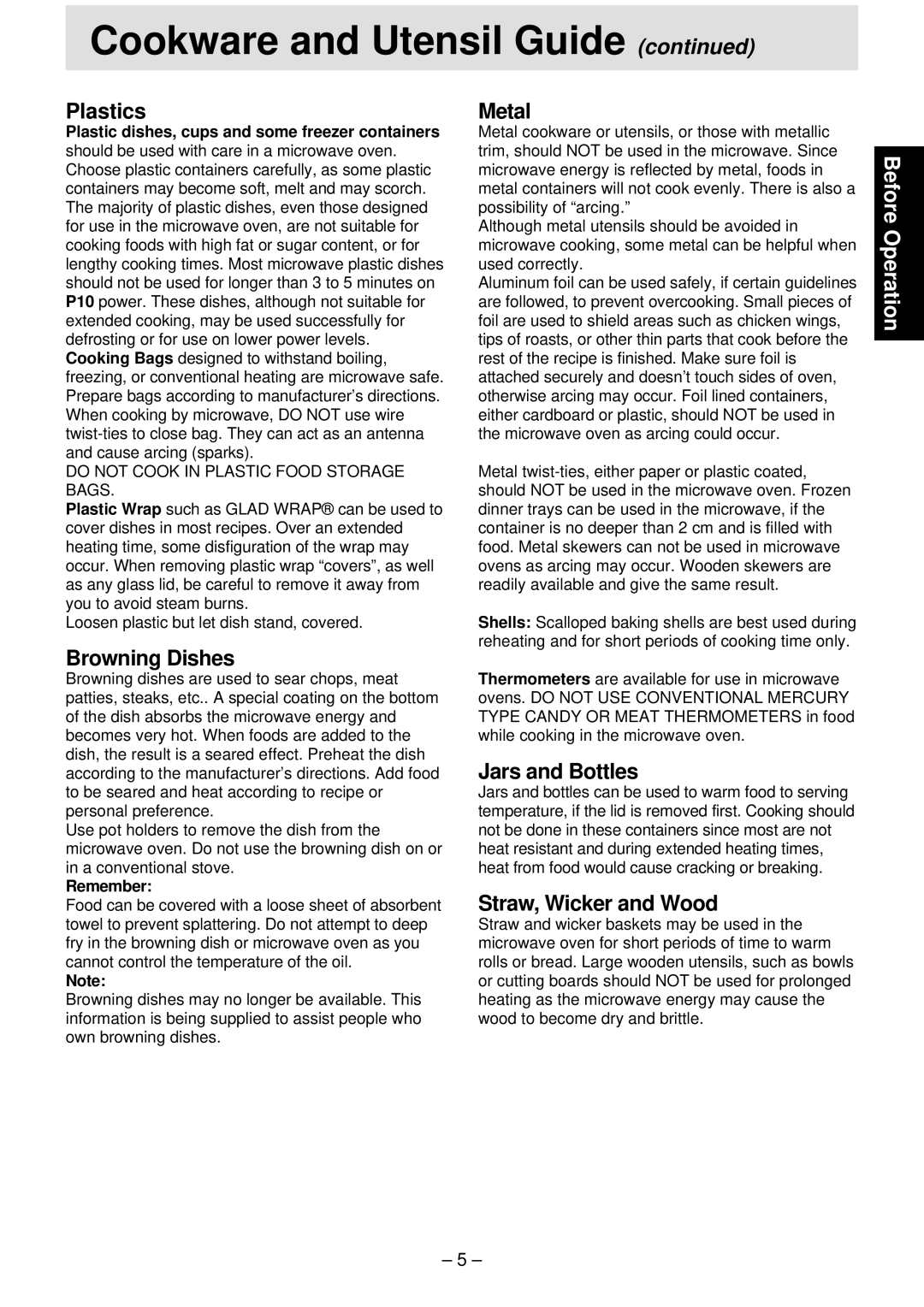Microwave Oven
Serial Number
French Forest NSW
Customer Care Centre
Model Number
Table of Contents
Inspection for DAMAGE.A microwave oven
Safety Instructions
Important Instructions
Earthing Instructions
Circuits
Installation and General Instructions
Placement of Oven
General Use
Glass, Ceramic and China
How to Test a Container for Safe Microwave Oven Use
Reflection
Paper Products and Freezer Wrap
Jars and Bottles
Plastics
Browning Dishes
Metal
External Air Vents Oven Window with Vapor Barrier Film
Feature Diagram
Door Safety Lock System Roller Ring
Glass Tray
Control Panels
Restart oven
Start Pad
NN-S761
NN-S751
Operation Guide in the Display Window
Let’s Start To Use Your Oven
Enter Time of Day
To Use Child Safety Lock
To Set Clock
Press
To Set Standing Time
To Use Timer Pad
To Use as a Kitchen Timer
To Set Delay Start
Press
Micro Power and Time
Micro Power
NN-S781 NN-S761
To Reheat by Micro Power and Time
To Defrost
Set Weight
Defrosting Technique
Defrosting Chart by setting Micro Power at P3
Defrosting Tips and Techniques
Preparation for Freezing
NN-S751
Serving / Weight
Pad
Frozen Reheat-Plated Meals 250 g 850 g
Auto Reheat 850 g
Root Vegetables 180 g 500 g
Rice1 cup
Fish 120 g 500 g
Dried Pasta 150 g 500 g
Fresh Pasta 150 g 500 g
Meat Sauce 250 g 1000 g
Sensor Cook
Select Category
Category appears in the display window
If desired, press
Sensor Reheat
Cover foods securely with plastic wrap or a fitted lid
Sensor Reheat-Reheat 1.0 kg All Models
NN-T791/NN-S781/NN-S761
Foods should be completely frozen
Root Vegetables 1.0 kg All models
Fish 120 g 1.0 kg All Models
Vegetables Steamed Vegetables 1.0 kg All Models
White Rice 200 g 500 g All Models
NN-T791/NN-S781/NN-S761 Slow Cook 500 g 2.0 kg
Beef 1.0 kg 2.0 kg
Lamb 1.0 kg 2.5 kg
Chicken Pieces 1.5 kg All Models
Recipe
To Use Recipe Prompting
NN-T791 NN-S781 NN-S761
To Use Recipe Prompting
Key to Symbols Used In Recipes
Food Characteristics
Techniques for Preparation
Rice Pasta
Covering
Browning
Standing Time
Converting Recipes from Other Sources
Menu Planning for Microwave Cooking
Increasing & Decreasing Recipes
Cooking for One
Hint
Everyday Basics
Ingredients
Method
To Reheat a Croissant
To Reheat Filtered Coffee
To Toast Coconut
To Reheat 2 Cups of Cooked Rice
To cook by Sensor Cook
To Reheat Pouring Custard
To Heat Baby Food
Variations
Onion, finely chopped
Onion, diced Cups Chicken stock
Curry powder Pepper
Place butter and mushrooms in 2-litre casserole
To Make Croutons
Worcestershire sauce
Cup Chilli salsa 200 g Packet corn chips Grated cheese
80 g Butter
Curry powder
Eggs, separated
⁄2 cup Chopped salami 50 g
Teaspoon Mixed dried herbs
Place pita bread onto dinner plate. Spread each
Directions for Cooking Fish and Shellfish by Microwave
Fish and Shellfish
Clove garlic, crushed
Bouillabaisse
Fresh mussels
Leek, sliced
Spring onions, sliced
500 g Whole fish, cleaned and scaled Bream or Snapper
Squid, cleaned and sliced
Melted butter, divided
Directions for Cooking Poultry Pieces by Microwave
Poultry Chart for Microwave Cooking by Time
Poultry Power Temperature
Poultry
Honey Mustard Glaze
To serve
Laksa
Soup
Method Laksa
Seeded mustard
Cornflour
⁄4 cup Lemon juice
Then Start
200 ml
APPROX. Cooking Time
Meat Chart for Microwave Cooking
Main Fare Meats
Directions for Cooking Tender Cuts of Meat by Microwave
Shredded fresh basil
500 g Lamb, diced Onion, chopped Clove garlic, crushed
Prepare as above. Cover with plastic wrap Press
Thai green curry paste
750 g Liver
Garam masala Teaspoon Dried thyme Cup
600ml Hot chicken stock 150g
Serve
Steamed rice
500 g Lamb mince Onion, chopped
Beef stock powder
450 g Potatoes, peeled and finely diced Cups Water
Cheese Sauce
Method Meat Sauce
Directions for Cooking Vegetables
Frozen Vegetables Chart for Microwave Cooking
Dried Beans and Peas Chart for Microwave Cooking
Vegetable Varieties
Vegetable Quantity Cooking Procedure Time
Fresh Vegetables Chart for Time Cooking
On P10
Press Root Vegetables , then Start
Butter 150 g
200 g Zucchini, sliced Capsicum, sliced Onion, sliced
⁄2 cup Tomato purée Teaspoon
250 g Brussels sprouts
Fresh basil, chopped
500 g Carrots approximately
Peel and thinly slice carrots. Combine all ingredients
Butter Salt and pepper
Finely chopped parsley
Cup Sour cream ⁄4 cup Milk
200 g Sliced snow peas Sliced carrots Sliced zucchini
Tomatoes large
APPROX. Time Amount
Rice, Pasta and Cereal
Directions for Cooking Pasta by Microwave
Directions for Cooking Hot Cereal by Microwave
Cups Hot chicken stock 11⁄2 cups
Serves 6 to
500 g Mussels ⁄4 cup Water
Cups Long grain rice
Teaspoon Turmeric
Olive oil Cups
Cup Milk 375 g
Precooked lasagne sheets
Sauce
To Melt Chocolate
Cakes, Desserts and Slices
Icing
To Blanch Nuts
Custard
Filling
Christmas Pudding
⁄2 cup Brandy 250 Butter Brown sugar Eggs
Flour, sifted
Canned apples
To prepare topping
Topping
To Soften Dried Fruit
Chopped peanuts
Oatmeal Cookies
300 Chocolate pieces
400 g Condensed milk
Steamed Hand Towels
Micro-made Extras
Lemon rind
Stirred Custard
Makes 1 cup 250 ml
⁄ 2 cup Lemon juice
Cream and stir until combined. Serve over ice cream
Flour 11⁄2 cup Milk Grated cheese
Condensed milk ⁄4 cup Brown sugar
Combine condensed milk, brown sugar and golden
Cooking Sauces
Cakes
Beef
Beverages
Biscuits
Potato
Lamb
Noodles
Pork
Soups
Preserves
Pudding
Sauce
Before Requesting Service
Care of your Microwave Oven
Before Cleaning
For ALL Models
Quick Guide to Operation
To use Turbo Defrost Pad
To Cook using
To Reheat using Sensor Reheat
To Reheat using
F00035B00QP OA0501-0

